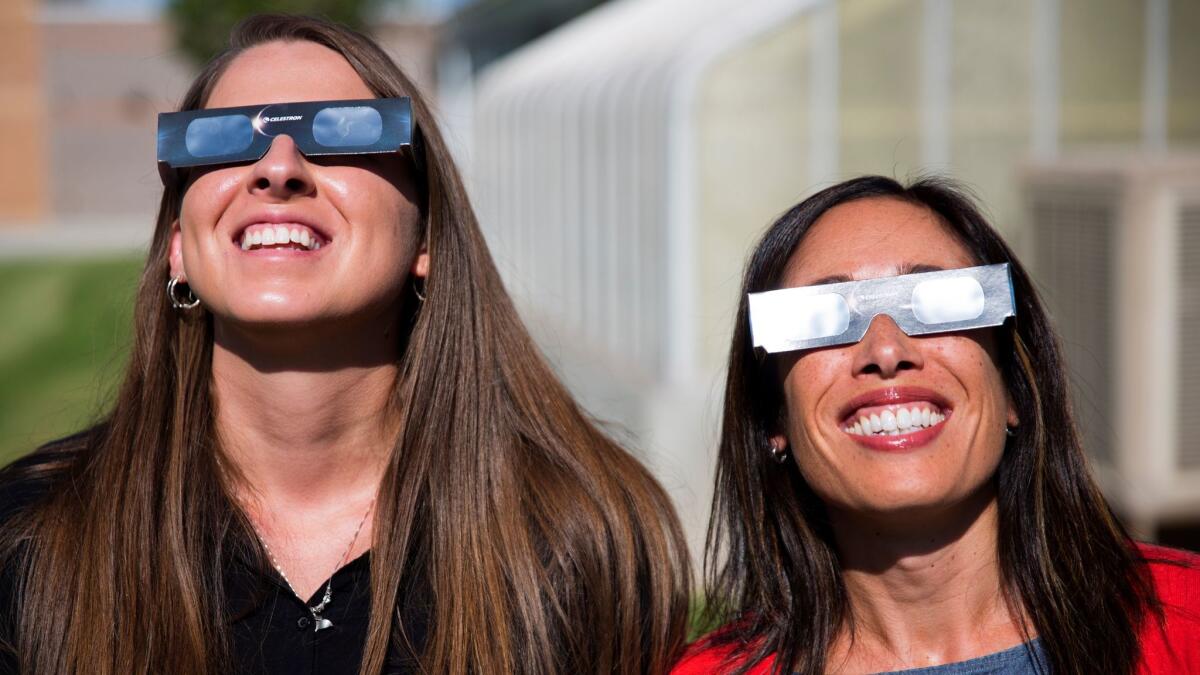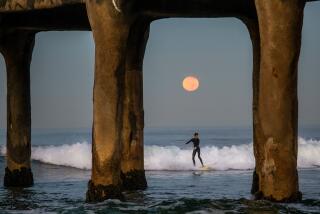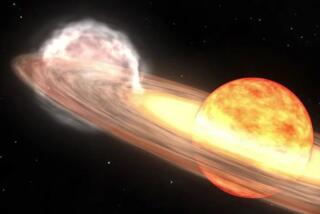Op-Ed: Tracking the ‘eye of God’ — a total solar eclipse comes to North America

What is the most beautiful natural phenomenon you have ever seen? A brilliant rainbow set against a distant storm, the shimmering aurora in an Arctic night, or a blood-red sky just after sunset, perhaps? Here’s what puts all those in the shade: the diamond-ring effect that heralds a total solar eclipse, an explosion of light on the edge of the moon’s inky circle, as it blots out the sun.
When the moon is in direct line of sight of the sun, a “totality” completely and precisely blocks our central star from view, casting a shadow on Earth’s surface about 100 miles in diameter. As our planet spins in its daily round, that shadow rushes across land and sea at about 2,000 miles an hour. If you are in its direct path, you’ll never forget it.
Total solar eclipses occur at regular intervals, but each time a mere 0.5% of Earth’s surface is totally obscured by the moon’s shadow. On Aug. 21, for the first time in a century, that 0.5% will cross the whole of North America, more or less kittycorner from northwest Oregon through Idaho and across Wyoming, Nebraska and Missouri, then parts of five more states to South Carolina, potentially creating the largest-ever audience for a totality.
There is a slow build-up to the main event. It takes about an hour for the moon to gradually cover the sun. The bright disc shrinks to a sliver and twilight falls, giving the illusion that the sun is disappearing. This frightened the ancients, who feared that the source of all life was about to be extinguished.
As the last of the sun vanishes, the temperature drops, and from the west, a wall of darkness, the moon’s shadow, approaches. In an instant you are enveloped by gloom and the moon has appeared — in silhouette — as if from nowhere, like a rabbit from the conjurer’s hat. This is a truly weird phenomenon.
The sounds of animals cease, and life seems in suspended animation as for a few minutes night comes to the dome of the sky directly overhead, and covers the land from one horizon to the other. Look up, and you will see stars as if it were normal night, but accompanied by a blackened moon surrounded by sun’s shimmering white corona, like a black sunflower possessed of delicate silver petals.
One watcher has described it to me as “looking into the valley of death with the lights of heaven far away calling for me to enter.” Another exclaimed: “Is that the eye of God?”
Minutes later, daylight returns in an instant; more magic.
I saw my first partial eclipse as an 8-year-old at school in Great Britain. My teacher told me I would have to wait 40 years to see a total eclipse in England. So on Aug. 11, 1999, with my wife and elder daughter, I traveled to the southwest tip of the country, to the path of totality. We carefully placed ourselves on the center line of the eclipse, but thick clouds hid the sun from view.
At 11 a.m., with just minutes to go before my first totality was supposed to arrive, the gloom wasn’t lifting. What I had waited most of my life to see would unfold on the far side of a curtain, out of sight. All I could do was to look to the west, from where the shadow would come, in the hope of some small break in the clouds.
There was none. Instead, in the distance, blackness signaled what appeared to be a storm of gargantuan intensity gathering just beyond the horizon. Then I realized: This was not more bad weather, but a dramatic overture.
The vision was terrible, apocalyptic. Blackness swelled out sideways and saturated the distant sky in less time than it takes to articulate, like a tsunami rushing towards me, swallowing up the intervening space.
Within half a minute the moon’s shadow enveloped the landscape all around me. Utter silence descended. It was as if a black cloak had been cast over everything. And then I watched the moon’s shadow rush away eastwards, dissipating, and the birds and animals reawoke.
I had chanced upon a unique eclipse experience, a darkness upon a darkness, that I have never again witnessed. Even concealed, the totality was magnificent.
After the thrill of an eclipse you can’t wait to do it again (I’ve now seen six total solar eclipses), but wait you must until that exquisite alignment of sun, moon and Earth comes around once more. When it does, you must go to wherever the moon’s shadow will momentarily sweep across a small part of the globe. Anyplace else and at best you’ll see a partial eclipse, or nothing at all.
I say, if you can get to the totality, go — whatever it takes. I am bringing my children and grandchildren with me to the North American show, so they can have a lifetime’s memory. Cloudy or clear, it will be worth it.
Frank Close is a British particle physicist with a lifetime fascination with eclipses. His latest book is “Eclipse: Journeys to the Dark Side of the Moon.”
Follow the Opinion section on Twitter @latimesopinionand Facebook
More to Read
A cure for the common opinion
Get thought-provoking perspectives with our weekly newsletter.
You may occasionally receive promotional content from the Los Angeles Times.







